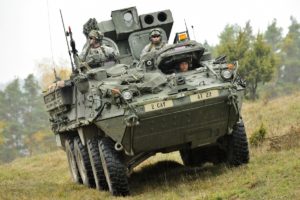Raytheon, along with the U.S. Army, tested a Stinger missile mounted into a Common Remotely Operated Weapons Station (CROWS) atop a Stryker Vehicle at the White Sands Missile Range in New Mexico. The successful test carried out in September of 2017 combines two proven systems giving the U.S. Army an immediate short-range mobile air defense system.
As adversaries continue to stock up on drones, rockets, and missiles the U.S. Army is scrambling to build its short-range air defense forces devastated by a decade of cuts. The Army is looking at an array of anti-aircraft systems including missiles and lasers to fill the void.
Raytheon incorporated the Stinger missile into a Common Remotely Operated Weapon Station, or CROWS, and mounted it on a Stryker. During a late September demonstration at White Sands Missile Range in New Mexico, the Army fired Stinger missiles from a Stryker vehicle and successfully intercepted airborne targets.
“With so many airborne threats in the battlespace, our ground forces need the protection of additional mobile air defense systems,” said Kim Ernzen, Raytheon Land Warfare Systems vice president. “Combining these two proven systems gives the Army an immediate, low risk, high-value solution.”
The Army is now evaluating the Stinger missile/Stryker vehicle solution.
The Stinger weapon system is a lightweight, self-contained air defense system that can be rapidly deployed by ground troops and on military platforms. It’s combat proven in four major conflicts and in use by more than 20 nations as well as all four U.S. military services.
Source: Ratheyon





